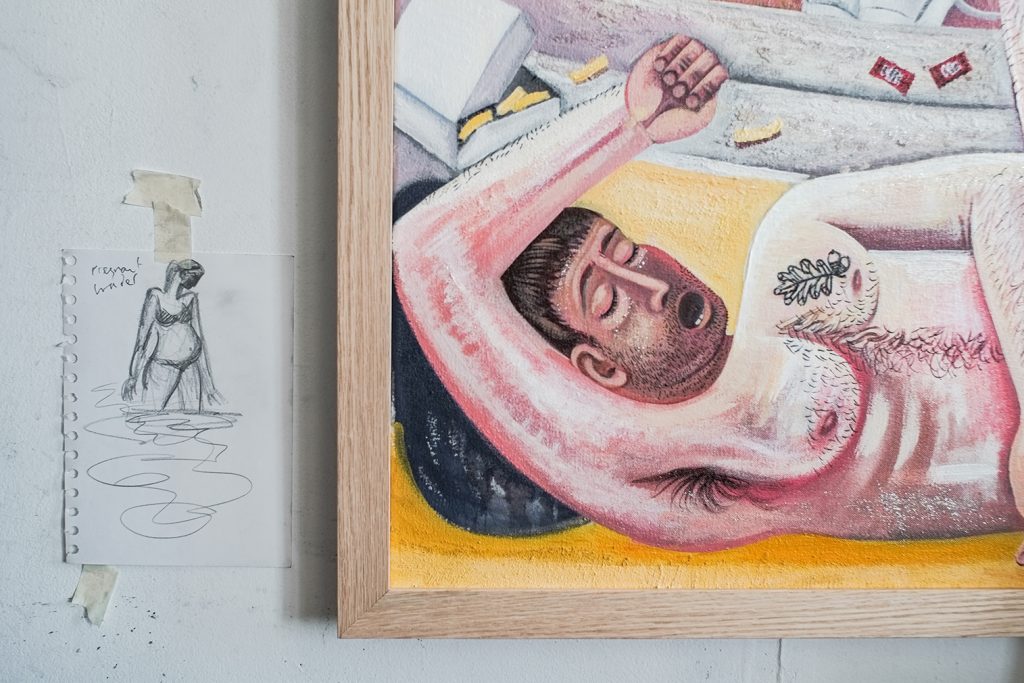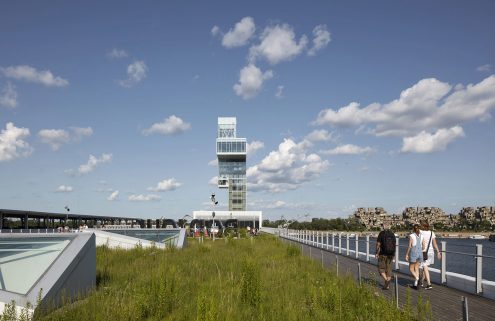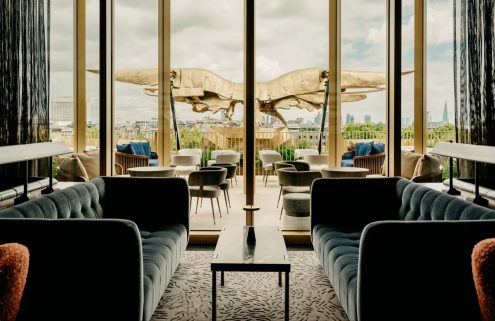Ed Gray is a painter of city life in all its grime and glory. Enthused with the spirit of Hogarth, Dickens and Lowry, his paintings reveal the ever-changing relationship between people and the built environment and offer an empirical exploration of civic identity.
Like mudlarking on the banks of the Thames, Gray’s work divulges a history hidden beneath the surface that is revealed only to those with the sharpest of eyes.
‘The Thames holds its secrets, the filth that Londoners flush away, until low tide uncovers them all,’ he says wryly.
Layers of familiar characters – commuters, shoppers, market traders; ambling school children, flustered city workers, harassed cyclists, outraged cabbies; apocalyptic street preachers and melodious buskers – familiar from our daily journeys through the city are keenly observed and celebrated within the scenes as a sort of theatre of urban life.

Ed Gray in his studio. Photography: Thomas Lyons

A detail from ‘Everybody Loves the Sunshine’, 2022 (c) Ed Gray. Photography: Thomas Lyons

Photography: Thomas Lyons

Photography: Thomas Lyons

Photography: Thomas Lyons

Photography: Thomas Lyons
But we aren’t mere observers. The viewer is inside the work; ‘That’s what takes the time,’ Gray says. ‘Creating the space within them to become part of them.’
Gray is afraid of leaving anyone out and always tries to find ways to place them in the background. Often, people recognise themselves, although Gray doesn’t know them personally, as everyone is a stranger to him.
‘I call them the lost and the nameless,’ he says.
Gray only works from sketches and refers to his collection of provisional pencil and charcoal drawings to produce the final work in the studio. Depending on how much truth is in his sketches, it can spark a memory or mislead him, sometimes wasting weeks in frustration as he attempts to recall his initial attraction to the person on the street.
The Eye

Some works are closer to his heart than others. ‘Threadneedleman – Rock of Eye’ carries a very personal meaning and features his friend and tailor, George Dyer, who recently passed away.
A chance happening 20 years ago sparked their lifelong friendship when Gray took a pair of trousers to be altered, which led Dyer to make his wedding suit. Gray realised the two were kindred spirits – solitary, obsessive creators of their respective crafts.
George Dyer was also known as the philosopher of Walworth Road and would hold court at the local cafe as its resident sage and comforter. Gray’s meandering conversations with Dyer would leave him lighter – and enlightened about his own practice and place in the universe.

‘Two empty cups left on the Formica, two replenished souls,’ he says.
In his painting, the tailor carries the ‘rock’ in his hand, the chalk used to mark the lines of a new suit. Dyer called this process the ‘Rock of Eye’, meaning to use your intuition and feeling to create, to come to a conclusion without drawing preconceptions, and work as a labour of love. This mantra resonated with Gray, and he has carried it with him through his work long after George Dyer’s passing.
The Lido

Gray’s most recent public painting is of the Parliament Hill Lido and hangs proudly in the pool’s cafe. Today, as it glistens in the last of the summer sun, it looks almost like a reflection of the characters in the water outside the cafe windows.
‘I’m not religious but the paintings do act as a spiritual and physical place that the audience can enter and participate in,’ he says. The Lido certainly has the feel of a temple, the awning shrouding the centre of the artwork.
Many of his influences belong to the Renaissance, and the triptych features in many works. The triangulation of the three-sided lido and an ever-present motif of the mother and child features throughout the painting strengthens the connection.
But above all, the work is always personal.

There has to be a connection to the subject for Gray and, for the viewer, freedom to interpret.
The paintings are unglazed, allowing viewers to get closer to the work without barriers. The cafe’s owner has enjoyed having the artwork on show, so much so that she’s crowdfunding to purchase it for the space permanently.
Gray started working on ‘Everybody Loves the Sunshine’, as the lido work is titled, in January 2022, and the final version was completed in July. Two alternate versions were discarded during the process (though you can see them on the back of the original canvas.) Gray’s perfectionism often means discarding drafts and missed deadlines.
‘But how do you know when it’s finished?’
‘It builds and builds to crescendo, coming together, becoming alive, the painting tells you what it wants, and is the most joyous finale to the process.’
Art College

In the mid-1990s, when Gray was a student at art college, figurative painting wasn’t much in fashion. Nor were his influences – figures like Stanley Spencer, the Renaissance painters and Jock Macfaden (who remains a close friend).
When he graduated in 1995, there were few opportunities for emerging artists. The young gallery scene had yet to appear, and only people of a certain income bought original art for their homes. But, work that was the antithesis of his own style changed and inspired Gray as the YBAs took the system into their own hands and became fully independent of the old institutions.
Their early work still excites him, but he sees the repetition of work that comes out now as mundane.
As we walk around the lido, a bellowing voice stops us in our tracks and takes us back to our youth, ringing out: ‘Boys – do not run!’ The voice belongs to Ricky, the lifeguard, who appears in an earlier lido work that we suddenly find ourselves standing in front of.
Ricky stops to chat to Gray about the show’s closing event that evening before walking off to chastise more rule breakers – ‘Girls, you’re going to fall over and hurt yourselves!’ The first Lido painting was done in 2012, and while he’s seen Ricky many times since, Gray had never met him until now. Ricky was just another stranger inhabiting his canvas.
Euro 2020

Ed Gray and I grew up in similar times, and both recognised a lot of hope in Britain as the 1990s turned into the Noughties. Sadly, (we agree) much of that optimism has now disappeared.
Recently unwrapped in the studio is his painting, ‘Still Dreaming’, its tragic characters draped in the Union Jack’s red, white and blue. It’s more Eng-Ger-Land than Land of Hope and Glory and reflects the tragic direction Gray feels Britain has taken in recent years.
What does it mean to be British in 2023? It’s an identity that is increasingly hard to find, and it’s easier to revert to the stereotypes we are fed and often baited by. It’s always been the role of artists to show these characters in a true light, explains Gray.
‘I went to see Jerusalem recently, and there’s a lot of the ‘Englishness’ I find fascinating – the antihero and the Hogarthian spirit. That’s the kind of thing I’m interested in.’
Hogarth’s own ‘modern moral subjects’, as his comic-like series of pictures were called, were powerful satirical and political illustrations of a similar style that were hugely popular and influential.
As we talk, the sound of hooves drifts through the window as the mounted police go by, the sound taking us momentarily back in time, bridging the centuries between artists.
The Sketcher

While Gray field-sketches strangers daily, he’s only been stopped by them twice.
Once was in Liverpool Street Station, by an unsure security guard. After some discussion, he became more interested than aggressive in Gray’s activities, especially when he saw he had already been featured in the sketchbook.
The other time was in Tokyo at the top of a public viewing gallery. The person politely approached him, amongst a sea of snapping cameras, to tell him he wasn’t allowed to sketch in his notebook. Paradoxically, one of Gray’s favourite artists is Hokusai and he was drawing the view of Mount Fuji at the time.
Soho

Gray’s current work captures the view outside The Dog & Duck pub towards Frith Street in Soho. He’s had the idea for four years; an edifice at the end of Bateman Street, hollowed out so you could see through it, seemed to be the perfect symbol for a changing Soho. And after the light and water of the lido, it makes a nice change to work on nighttime scenes again.
It means Gray can express the other side of the city.
The side where the bar crawlers and the nighthawks appear, the lovers and fighters in the evening streets, the night bus passengers and the rough sleepers passing through the endless all-consuming cycle of the city, captured first in pencil and paper and then immortalised on canvas.
Of course, Renaissance and classical works remain influential across all of Gray’s works. His Soho painting references Titian’s Diana hunting Actaeon – the stag, in this case, on his stag do, being hunted down by drunken friends.

While Gray’s not interested in the religious intonations of the historical paintings – he is fascinated by their humanity and spirit. They also taught him how to give depth of meaning to this work.
He even started his own Adoration paintings a few years ago – but his was an adoration of the city, not the Magi.
Not that it’s unconditional love.
‘It’s not about thinking that the city is such a great place – it’s just so amazing. It’s about the creative kind of joy that you get from depicting something that is impossible to predict and claim,’ explains Gray. ‘The challenge of painting something that is always changing. It never stops moving. It’s impossible and frustrating – but it gives so much to you when you finish the painting.’
Brexit

Gray knew he wanted to create something to express his anger at Brexit. For artists, he says, there can be no borders – there has to be a free flow of culture and inspiration for them to flourish.
He went to Westminister to watch the marches and protests, wondering how he could paint something that would say anything relevant.But he couldn’t work out how to get the madness of Farage masks and fascists to work in his painting, ‘Ode to Joy’.
The piece struggled.
So he looked back to the Renaissance for inspiration.
Gray studied the Old Masters’ inclusion of perfection in paintings and particularly the importance of the circle for its balance and symmetry. The next day he went back Old Palace Yard to paint and noticed a sundial on the floor he’d never seen before. Gilded across it it was a quote from Shakespeare’s Henry VI, Part III.
See the minutes, how they run,
How many make the hour full complete;
How many hours bring about the day;
How many days will finish up the year;
How many years a mortal man may live.
Henry VI deals with the English political system being torn apart by personal squabbles and petty jealousy after the loss of England’s French territories, leading to the Wars of the Roses, as two rival contenders fight for the right to rule England their way.
There too, was the meaning of Ode to Joy – man’s feeble mortality and the countdown to Brexit, captured in the purest form beneath their feet. All the characters in the painting dance around the dial in a circle of their own pomp and lies.
The Work

Gray doesn’t just replicate what he sees in front of him. His paintings course with allegory and symbolism, some more obvious than others.
‘Often, you don’t know why you are painting something until the end of it.’ As he works, the subliminal messages he needs to express become imprinted into the paint and canvas.
Gray paints because he has to.
‘You make the work that you think is saying something about the place where you live. I’m compelled to make this work because I don’t see it. I don’t see people painting work about people.’
He only makes a few paintings a year and usually sells them, though he doesn’t often show them.
‘I overpaint a lot of work as well. I’m not churning them out – I’m churning them in!’
And he doesn’t talk to his family about his work when he leaves the studio. He wants to go home and forget about it: if he asked for opinions, he would share doubt, negativity creeps in, and the work falters.
‘Shut the door, walk away, and come again the next day,’ he says. ‘Think about what isn’t working and what we can do about it today.’
Gray says he prefers musicians to artists, who can be difficult. There’s a competitive element to discussing work that isn’t healthy. Better to just be doing your own thing.























